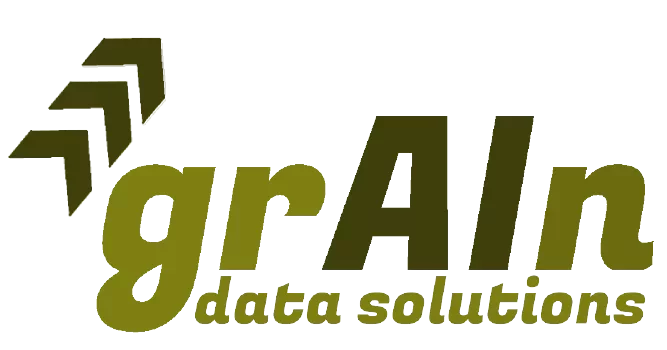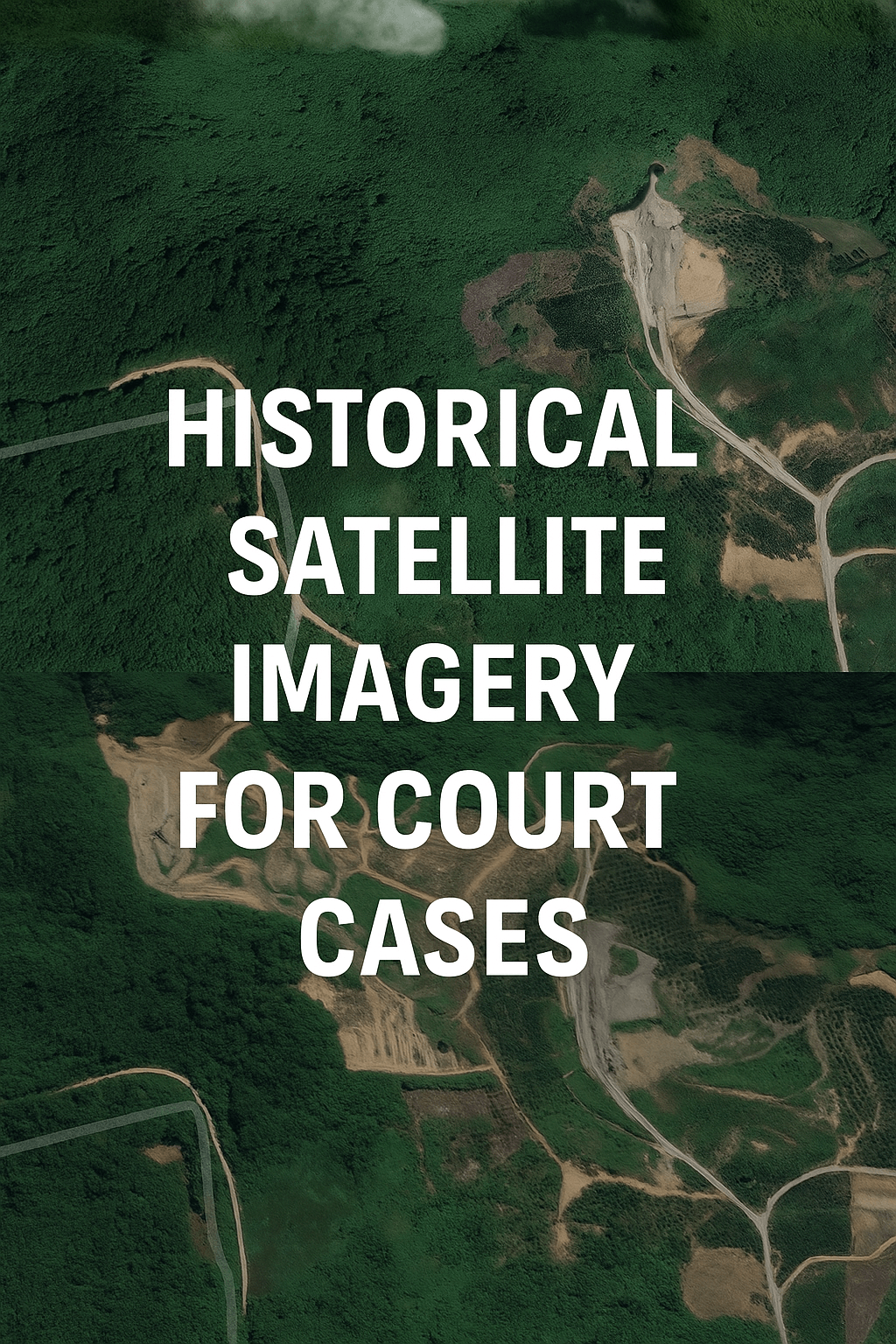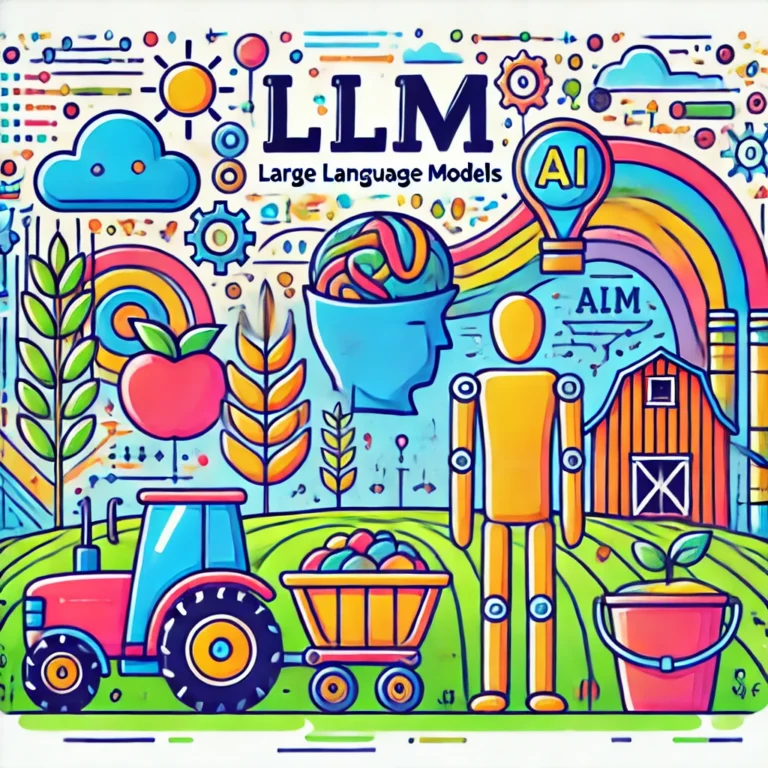Introduction
As we enter the new era of Generative AI (Gen AI) and explore its potential implications for the farming industry, it’s hard not to feel a sense of déjà vu. The familiar pattern of technological adoption in agriculture over the past 15 years—through drones, precision agriculture, digital farming tools, data science, and AI—along with the recent excitement in the soil carbon credit market, has gained significant attention and capital. However, the pace of adoption and success of business models often differ significantly from initial expectations. Large language models (LLMs), such as ChatGPT, won’t be an exception. While the exact impact of this new wave of tech advancement on farming in the next decade is unknown, there’s no doubt that it will replace some old ways of doing business in the agricultural value chain. In this post, we’ll explore its potential implications.



Grain Data Solutions is backed by the Sustainable Canadian Agricultural Partnership to develop a Specialized AI Assistant for the Ontario Crop Advisory System using LLMs.
Opportunities and Challenges with LLMs
Opportunities
1 - Expansive Data:
The agricultural industry generates an enormous amount of data, ranging from crop yields and soil conditions to weather patterns and market trends. LLMs can process and analyze this expansive data quickly and accurately, providing agricultural professionals with actionable insights. This capability allows farmers to make more informed decisions about planting schedules, crop management, and resource allocation, ultimately leading to improved productivity and profitability.
2 - Scattered and Non-Structured Data:
Agricultural data is often scattered across various platforms and formats, including research papers, extension services, market reports, and personal records. This unstructured nature of data makes it difficult for farmers to access and utilize effectively. LLMs can consolidate and structure this scattered information, providing a unified view that is easy to navigate and interpret. By aggregating data from diverse sources, LLMs help farming stakeholders access comprehensive and relevant information without the hassle of extensive searching, enhancing their ability to implement best practices and innovative solutions.
3 - Multi-Feature Problems:
Agriculture involves complex, multi-feature problems that require considering numerous variables simultaneously, such as soil health, pest management, weather conditions, and market demands. LLMs excel at handling multi-feature problems by analyzing multiple data points and identifying patterns and correlations that might not be immediately apparent. This ability to integrate and process diverse data types enables LLMs to offer holistic solutions tailored to the unique conditions of each farm.
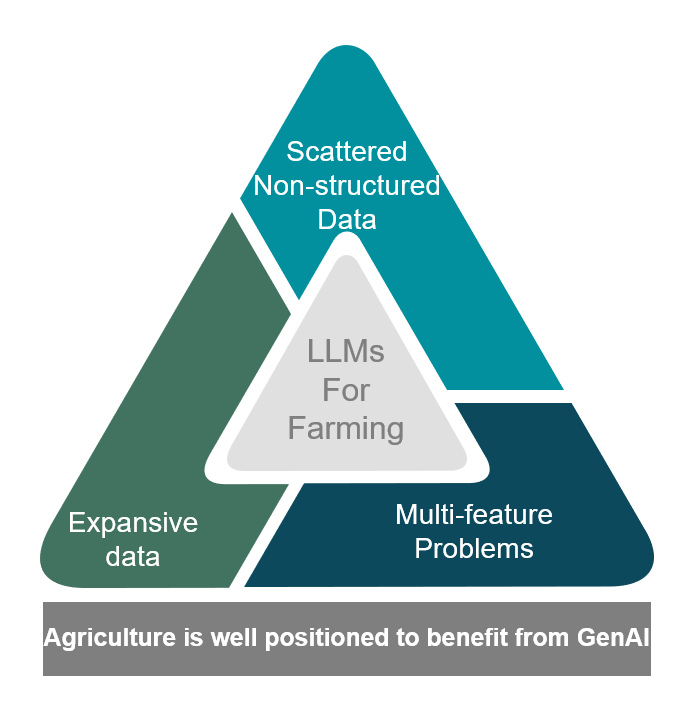
Challenges
a. Overly General Responses:
While LLM-enabled insights can be helpful for beginners, they often fall short for those with extensive knowledge and practical experience. For instance, asking GPT about the economy of farming corn and grain marketing strategies in the Midwest US might yield a well-prepared answer, but no experienced corn farmer in the Midwest would ask such a broad question. Most farmers are very well-informed about their specific practices, and LLMs often provide answers that lack the depth and specificity needed for experienced farmers.
b. Lack of Context:
Even if a model is trained solely on relevant information (e.g., agronomic fact sheets on location, weather, crop type), it may still lack the necessary context for fair judgment. Without precise background information, LLMs might deliver generic advice, failing to consider very local conditions and specific needs. A farmer or advisor knows particular details about their farm that LLMs can’t access unless prompted with specific follow-up questions.
c. Hallucinations:
LLMs can generate incorrect and fictional information which is called hallucination. While this isn’t a major issue for trivial questions, in agriculture, mistakes can lead to costly consequences. It’s crucial to avoid unreliable recommendations.
d. Trust Issues:
Farmers are cautious about relying solely on machines without human oversight. The integration of human expertise is essential to correct errors and build confidence in AI-driven solutions.
e. Data Privacy Concerns:
Data privacy is a significant concern when using LLMs in agriculture. Farmers need to ensure that their sensitive information, such as proprietary farming practices, financial records, and personal data, is protected from unauthorized access and breaches. Establishing robust security measures and transparent data policies is crucial to gaining farmers’ trust and ensuring the safe use of LLMs.

Applications of LLMs in Agriculture
I. Accessing External Insights:
LLMs can serve as powerful tools for accessing insights from external sources such as research papers, fact sheets, and guidelines published by farmers’ associations, university extensions, and government agencies. These resources are often scattered across websites, making them hard to locate through traditional search engines. An LLM interface can guide farmers to the exact paragraph or section of a relevant document. For example, a farmer might ask for pest management best practices for a particular crop, and the LLM can point them to a detailed research paper from a university extension. Similarly, queries about new irrigation techniques or soil health improvement strategies can be answered by directing the farmer to the latest studies and fact sheets from government departments. This targeted information retrieval ensures that farmers receive precise and credible insights without extensive searching, enhancing their decision-making process with authoritative data.
Accessing external insights provides farmers with quick access to comprehensive, up-to-date information, leading to better-informed decisions and more efficient farming practices. However, challenges involve ensuring the credibility of sourced information and maintaining a robust database to support accurate and relevant responses.
II. Agronomic Advisor Interface:
The scientific community has tested and showcased the superior performance of tools like ChatAgri, fine tuned LLM model and open source and proprietary models passing agronomic tests with high accuracy.The promising performance of tools like ChatGPT for standard agronomic questions has sparked the idea of using LLMs as agronomic advisors for farmers. Asking specific questions about cash crops from the latest GPT release can yield surprising knowledge. However, while a customized GenAI-enabled interface for farmers to upload an image of a withered leaf and ask questions about the cause and actions seems ideal, we are far from achieving that as a business reality. The lack of direct applicability has limited the adoption rate of tools like ChatGPT by farmers or their advisors. LLMs have the potential to enhance decision-making by providing access to vast agronomic data, bridging gaps created by scattered information. However, overly general responses and lack of context can hinder their effectiveness, and the risk of generating incorrect information makes human oversight essential to ensure reliability and build trust.

III. LLMs as Digital Secretaries:
Another promising approach for integrating LLMs in agriculture is utilizing them as digital secretaries to retrieve and manage information from Ag professionals, retailers and farmers’ documents. Instead of generating new information or offering recommendations, LLMs can organize and access existing data efficiently. Imagine a farmer asking the model to provide a summary of cropping history over the past decade, retrieve insurance documents, or compare this year’s soil test results with previous years. Additionally, LLMs can read and interpret complex chemical labels, machinery manuals, and warranty information, providing immediate and accurate responses. They can also manage irrigation schedules, livestock records, and financial statements, making it easier for farmers to stay organized and informed. This approach saves time and reduces human error, allowing farmers to focus on critical aspects of their operations. By acting as reliable and efficient digital assistants, LLMs can streamline the administrative side of farming, bringing practical benefits without advisory role complexities. However, challenges include ensuring the accuracy and relevance of retrieved information and managing data privacy concerns.
IV: LLMs as Chat-Bots for Agricultural Associations and Extensions:
Agricultural associations and extensions often house extensive resource centers filled with valuable information for growers and consumers. These resources include fact sheets, videos, research papers, blog posts, and more, crucial for education and decision-making. However, navigating this wealth of information can be time-consuming and daunting. By employing LLMs as chat-bots, associations can vastly improve user experience by enabling quick and easy retrieval of relevant information. Farmers and consumers can ask specific questions and receive instant, accurate responses, directing them to the exact resource they need without the hassle of extensive searching.
Moreover, implementing LLM chat-bots allows these entities to track user questions and concerns. This data can reveal trends and common inquiries, providing insights that help associations continuously enhance their knowledge centers. By identifying the most frequently asked questions, associations can create new resources and update existing ones to better meet audience needs. This ensures the information remains current and comprehensive and helps tailor resources to address emerging issues and interests within the agricultural community. Nonetheless, ensuring information accuracy, maintaining up-to-date databases, and addressing user privacy concerns are crucial challenges that need to be managed to build trust and ensure safe usage.
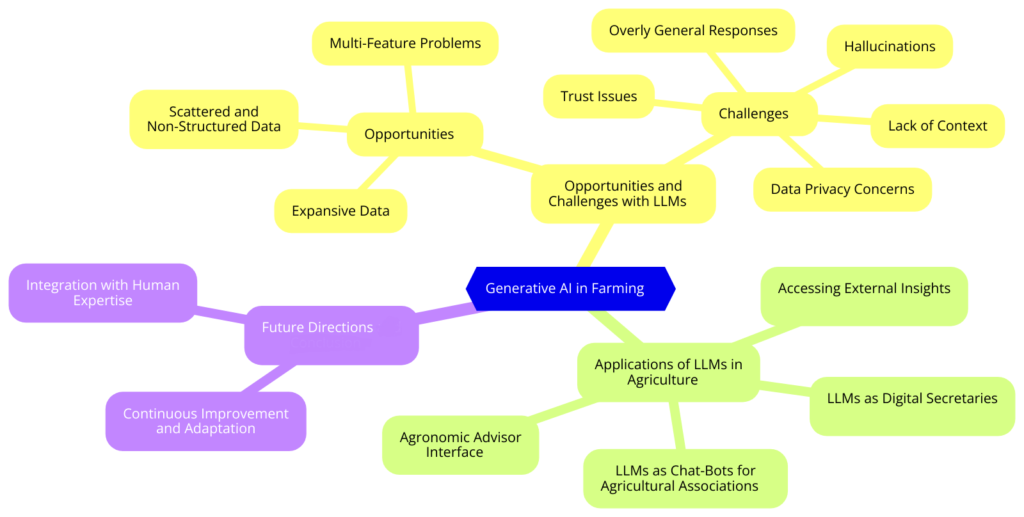
Future Directions
Building AI enabled tools for agricultural clients over many years, we understand that this new wave of technology has a lot to offer to this industry. However, as its current status, we expect followings to be essential part of LLMs journey in farming industry:
Continuous Improvement and Adaptation: As LLM technology evolves, its applications in agriculture will expand. Systematic efforts toward bringing in human feedback to refine and validate LLM outputs will be crucial for gaining trust and ensuring reliability. Developing more specialized models tailored to specific agricultural needs will further enhance their utility.
Integration with Human Expertise: Combining the strengths of LLMs with the deep, contextual knowledge of experienced farmers and agronomists will create a powerful synergy. This collaboration can lead to more accurate and relevant insights, improving decision-making and fostering innovation in farming practices.
